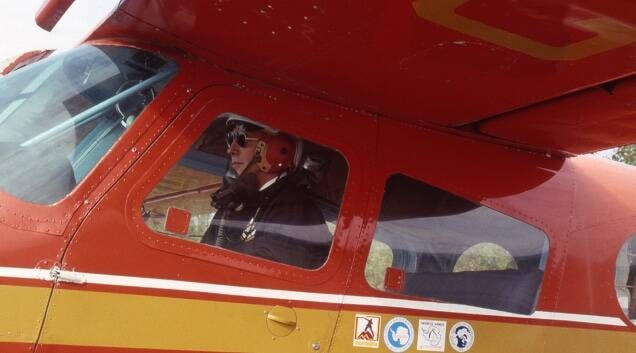I have the perfect idea if you’re looking for either a good Christmas gift or an idea for a less desk-bound job: Andy Williams’ new book Mount Logan and the Icefields: Yukon Flying Adventures.
You know you’ve got a good book in your hands when you open it at random and it has advice like this: “You need to know what the mountains look like from all different angles. Because you will get lost. And you need to be able to recognize the mountains from all sides.”
Williams’ new autobiographical account of his four decades flying climbers and scientists around Mount Logan and the icefields, published by MacBride Museum and packed with stunning photos, is the Yukon’s new must-have book.
The Yukon is a wild and rugged place. Which makes it jarring sometimes to eavesdrop on conversations in the capital city’s cafés and hear people complaining about boring Powerpoint presentations or the ordeal of having to reset the wifi connection to their garage door.
How about these challenges? Landing on a sloping glacier at 17,600 feet. Fitting a spare engine into your plane along with a gantry so you can replace the engine on a different plane already stuck on a glacier. Digging your plane out of six feet of snow and turning it around before that nasty storm you can see on the horizon buries it again. Or deciding if the expedition doctor helping you unload the plane is behaving sufficiently strangely that you’ll need to fly a second doctor in to deal with altitude sickness.
I don’t mean to pile any existential angst on you just before the holidays, but compare your curriculum vitae to the following and ask who would be more interesting to invite over for dinner: you or an ex-Royal Marine Commando who went on to be an Antarctic surveyor, research station manager on two continents, mountain climber and Yukon glacier pilot.
Even if, like most of us, you’re more comfortable risking computer crashes than plane crashes, Yukon Flying Adventures makes for a great read. It is based on Williams’ talk and photo show at one of MacBride’s Wayback sessions. The book connects the reader to the long and amazing history of alpine and glacier exploration in the Yukon, a topic usually restricted to a relatively small community of extraordinary Yukoners.
These stories are amazing on a number of fronts.
For climbers, there is the story of the first ascent in 1925. Without the benefit of airplanes, they slogged in to Mount Logan from Alaska (there is amazing film footage from this expedition in a documentary entitled Conquering Mount Logan you can find on YouTube).
For geologists, there are photos and stories about the early expeditions of Walter Wood and the founding of the Arctic Institute of North America. For biologists, there’s the ground-breaking High Altitude Physiology Study (HAPS), which researched the effects of the thin high-altitude air on unacclimatized individuals or those spending prolonged periods at altitude. In the 1960s this was high on scientific research agendas. In addition to novel activities such as high-altitude flight and space missions, there had just been a war in the Himalayas between China and India where Indian troops airlifted to high-altitude bases suffered significant casualties.
The HAPS study benefited generations of people at altitude, documenting conditions such as acute mountain sickness, pulmonary edema, retinal involvement, cerebral edema and Cheyne-Stokes breathing.
The need to build a sizable research base at high altitude led to a series of innovations and hair-raising adventures. They needed a plane that could land and take off with a load at 15,000 feet or higher. They learned that pilots in the Peruvian Andes were flying the Helio Courier, known for its short-takeoff-and-landing abilities, equipped with turbo-chargers at airstrips above 15,000 feet.
They decided to get one and try it with skis for glacier landings and take offs, eventually reaching 17,600 feet where the legendary Logan High camp would be located.
I once had the privilege of being flown in to King’s Trench on Mount Logan. It’s an experience you don’t forget, from the raw majesty of the mountain to the roaring power of the mighty Turbo Beaver aircraft.
The flight also reminds you, as the book does, that Kluane Park is enormous. Even if you paddle the Alsek River or hike in to the Kaskawulsh Glacier, you’re just barely on the edge of Mount Logan’s front yard.
For those of us with modern desk jobs, the book is a fascinating glimpse of the people who do glacier expeditions. For younger Yukoners, this book may be an inspiration to get that pilot’s license or scientific degree to work in places like Kluane. In much safer and better-known conditions, of course, thanks to achievements of the people smiling in the photos in Andy Williams’ book.
Mount Logan and the Icefields: Yukon Flying Adventures is available at the MacBride Museum, and the author will be signing copies Saturday, December 11 from 11 a.m. to 1 p.m.
Keith Halliday is a Yukon economist, author of the Aurore of the Yukon youth adventure novels and co-host of the Klondike Gold Rush History podcast. He is a Ma Murray award-winner for best columnist.
